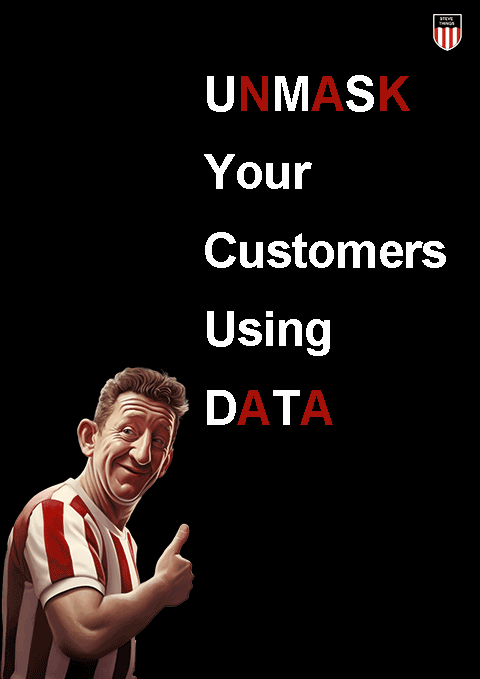How to get started with Analytics and Data
I’m often asked where do you start with Analytics? How do you go about doing it? The simplest answer to that question is start with your customers needs and work back from there.
To illustrate lets take a simple example
Imagine you sell photography equipment, cameras, film, tripods, lenses, that kind of stuff. These days your customers are all digital natives and they do things differently than they did 10-20 years ago.
The window shopper
So the first part of doing analytics is understanding that your customers are all in different phases of buying. Firstly you have people doing research, people window shopping online in effect, they may have seen a display ad online and got interested in you or done a web search about for instance a photographic lens and found your website. These are the people that you have to answer all their questions just like you would if they were in your physical store. As the owner of the business you have a wealth of information about what you sell and freely pass this information on when a customer asks about it. Your online presence should have all of that information on your web pages. Not only will that answer your customers questions but it will help you to rank highly on the search engines by demonstrating that you know what you’re talking about.
The prospect
Secondly you have the person that’s done the research, is ready to buy and just needs to find a good price or service. They may come to you directly or type in a really specific keyword like “Canon EF 600mm f/4L IS II USM Lens.” They know exactly what they want. This is where you need to close the deal. When you’re in your physical shop and the person is almost ready to buy you might try closing the deal by mentioning that the manufacturer has a lifetime guarantee on the lenses. You might also mention that the customer doesn’t have to pay in cash right there and then, that there is a payment plan that can be paid monthly. This kind of information has to be on the website. You want to show things like credit cards you accept front and center.
The customer
Thirdly there is the customer who has bought from you before. They basically know you’re great at what you do and when they come to your shop you greet them like friends, by name and because you know a little bit about them you can serve them much better. Online they’ll either come to you directly as they know you, or you might contact them by email, tell them you have something they might like and point them directly to the appropriate place.
You might call the first type the cold prospect, the second type the warm prospect and the third type your customer. These are what you need to add to your analytics tools as basic segments to compare.
So how do you do analytics around this?
So you have 2 types of prospect, your customers, using a variety of tablets, mobiles and desktops, coming directly to your website, from display ads, email, search engines as well as other sources like partner websites and social media. How do you begin to start measuring it all? Now is the time to start tying this into your business objectives. You first need to determine what’s important to you.
You might want to know what number of transactions you’re looking at per month, the amount of revenue generated, the conversion rate of each segment, how many page views they look at, how long they stick around and a bunch of other things that will help you make decisions. And because you know your customers use different devices, and are at different phases in the purchase cycle you need to somehow identify them in your analytics tools. You also know they come from different places or ‘sources’ so you need to segment those out too.
Defining a segment
One of the cornerstones of good analytics is segmentation. All analytics systems distinguish between new visitors to your website and repeat visitors. It might be fair to say that a new visitor to your website is a cold prospect because by definition they have never been to your website before. Of course this is a generalisation but the majority of people that have actually never seen your website before will be new visits. Repeat visitors might be one of the warmer prospects because by definition they have come back after seeing your website at least once. A customer is someone you can define as having spent €1 or more in your analytics tool.
You then need to look at the devices they’re using. So you need to set-up the analytics tool to recognise whether people come from mobile, tablets or desktops.
Finally you also need to understand where people come from. Since you as the business owner are doing some paid search marketing and you run some banner ads to attract attention on some big media sites you are very interested in knowing whether that activity is paying off. So you split your sources up into Direct traffic, Paid search, Organic (not paid directly for) search, Display, referrals from other sources and email for your customers.
Getting started with the measurement
Now you’ve done all the definition work you can get started with the measurement. You’ve defined your segments, device types, traffic sources and you have business objective metrics you can compare them against. You now start going into the data and looking for trends. Not absolute numbers but trends. Basically to start with you ask the same question for all the different aspects you can measure with your analytics tool. So you’re asking the question are there any major differences across language, location, engagement, the type of browser and operating system used, the type of pages accessed, the page time loading speed, the amount of transactions, products and revenue measured against your key metrics.

What does it all mean for the hypothetical photography business?
Asking the hypothetical question “is anything different across our customers compared to our prospects” we noticed that page time loading for customers wasn’t a problem. This was the “Good” part. The “Bad and the Ugly” however weren’t far behind.
Issue 1 – Page Load time
Page load time however was a big issue across everything else and needed optimising immediately. If customers page load times were faster than prospects then it could mean we’re losing business due to the page load time taking too long for certain segments of our visitors (in particular those coming from organic search or on a mobile – both areas we’d previously identified as important research tools for prospects). The photography site is content heavy and has hi-res pictures of various products which could be optimised without any negative impact.
Issue 2 – New visits bought less
We also noticed that new visits bought less (represented by the orange squares) which made sense since that is what we figured would happen, so nothing too much to worry about, but we thought we could do some testing around the new visits to try and serve them better by showing them more relevant pages if they had come from a search engine with various key phrases.
Issue 3 – Mobile and tablet experiences sucked!
Then we looked at the devices and across all the reports we checked we found lots of problems. A lot of folks were visiting with mobiles and tablets were hitting critical problems all over our website which clearly needs optimizing. Mobiles particularly were being really badly served.
Issue 4 – Got Safari? Got a problem!
Looking right to left when we checked the browsers and operating systems people used we saw huge differences. Critically it appeared that there are zero customers from Safari browsers meaning there had to be a problem. When you visited the website on an iphone using safari it crashed! This needed fixing straight away.
Issue 5 – Display ads sucked
We also noticed Display as a traffic source was very problematic. It seemed to have very few sales and very poor engagement across many of the metrics we checked. For these kinds of cases a take out test is best. You don’t do display ads for a month and see if the impact to sales across other channels (especially search engines) is significant. If its not then as a business you save your ad spend.
So just by looking at the basic reports in Google Analytics across different segments we managed to identify that our prospects weren’t being served well enough, especially our mobile and tablet prospects, we found we weren’t serving people who used safari browsers, we saw that the site took too long to load and that we might be wasting money on Display. Lots of work to be done!
In summary
To start doing analytics you need to start with the customer, prospect and window shopper segments. The example I showed here is not the same for every business but doing the definition work in the beginning is critical. Understanding that you’re dealing with different customers at different stages of the buying lifecycle (regardless of what kind of business you have) who use different devices and come from different places helps you to understand where to start to get the most from your analytics investments.
5 issues you can take to the bank, from simply doing segmented analysis.

If we have data, let’s look at data. If all we have are opinions, let’s go with mine.
